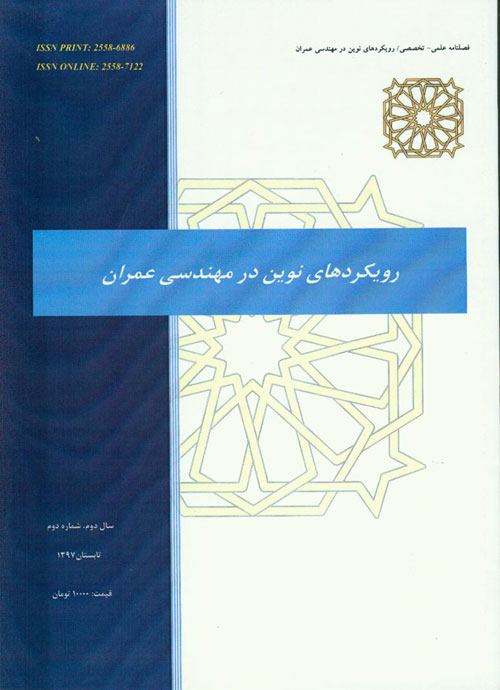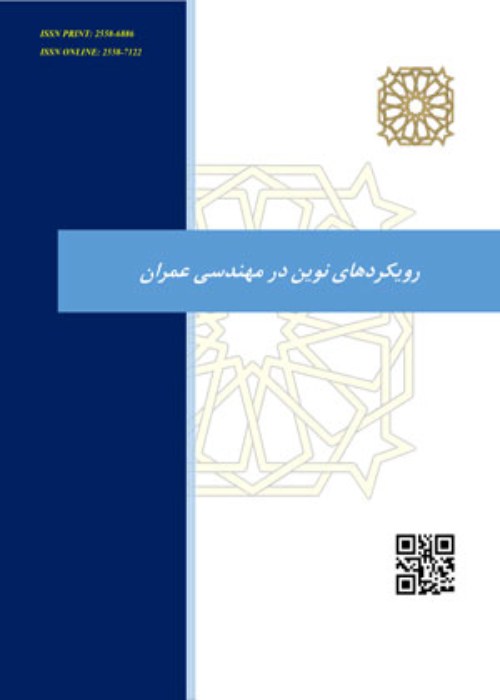فهرست مطالب

فصلنامه رویکردهای نوین در مهندسی عمران
سال دوم شماره 2 (تابستان 1397)
- تاریخ انتشار: 1397/07/14
- تعداد عناوین: 5
-
صفحات 1-10نتایج مطالعات قبلی نشان داده که مواد مکمل سیمانی، تاثیر بسزایی در خصوصیات رئولوژیکی بتن خود تراکم داشته اند. بدین سبب هدف از تحقیق حاضر بررسی نقش ضخامت لایه آب بر روی ویژگی های بتن خود تراکم حاوی دوده سیلیسی می باشد. از این رو رابطه بین جریان اسلامپ (T50) ، زمان جاری شدن قیف (V-funnel) و ویسکوزیته بتن خود تراکم حاوی درصدهای مختلف دوده سیلیسی با ضخامت لایه آب موثر مورد بررسی قرار گرفته است. نتایج نشان می دهد که ضخامت آب تجمیع شده در اطراف اجزای تشکیل دهنده بتن می تواند تاثیر بسزایی در خصوصیات رئولوژیکی بتن خود تراکم داشته باشد.کلیدواژگان: ضخامت لایه آب، رئولوژی، بتن خودتراکم، دوده سیلیسی
-
صفحات 11-26در این تحقیق، تاثیر استفاده از لایه های ژئوگرید در تسلیح خاک زیر پی برای مطالعه رفتار پی ماشین آلات صنعتی تحت بارگذاری متناوب به روش عددی اجزای محدود توسط نرم افزار ABAQUS مورد ارزیابی واقع شده و اثر تعداد لایه های ژئوگرید، عمق و عرض ژئوگرید، فرکانس های بارگذاری متفاوت وتاثیر استفاده از لایه های ژئوگرید بر روی مقادیر فرکانس مودهای اول تا سوم خاک مورد بررسی قرار گرفته است. نتایج حاصل از تحقیق حاضر نشان می دهد که با افزایش تعداد لایه های ژئوگرید، ظرفیت باربری پی افزایش یافته و عمق بهینه استقرار لایه ژئوگرید برای حالت دینامیکی برابر 0. 6 برابر عرض پی نواری می باشد. همچنین، با افزایش فرکانس بار دینامیکی تغییر محسوسی در ظرفیت باربری رخ نمی دهد و استفاده از مسلح کننده تاثیر بسیار ناچیزی بر روی فرکانس طبیعی خاک دارد.کلیدواژگان: پی ماشین آلات ارتعاشی، بهسازی، ژئوگرید، بارگذاری متناوب، ظرفیت باربری
-
صفحات 27-38آزمایش برش مستقیم با توجه به سادگی و در دسترس بودن، رواج بسیار فراوانی دارد. این آزمایش نسبت به آزمایش سه محوری به دلیل شکل خاص دستگاه و نحوه ی انجام آزمایش، مقادیر متفاوتی نسبت به پارامترهای واقعی مصالح پاره سنگی ارائه می کند. آزمایش سه محوری به دلیل امکان فراهم کردن شرایطی شبیه با رفتار سنگریزه ها در وضعیت طبیعی می تواند مقادیر واقعی تری از پارامترهای مقاومتی مصالح را ارائه کند. به دلیل زمان بری، پر هزینه بودن، مشکلات کار کردن با دستگاه سه محوری و دشواری آماده سازی نمونه ها، همچنان بیشتر از آزمایش برش مستقیم استفاده می شود. در این تحقیق با بررسی نتایج آزمایشهای برش مستقیم و سه محوری مصالح پاره سنگی، به مقایسه مسیرتنش در فضای pو q و زاویه اصطکاک داخلی این دو آزمایش و یافتن رابطه ای بین آنها پرداخته شده است. برای حصول اطمینان از نتایج به دست آمده، از اطلاعات آزمایش برش مستقیم و سه محوری بزرگ مقیاس استفاده گردیده است. مقادیر φ، τf، σn در هر مرتبه از آزمایش برش مستقیم استخراج گردیده و با استفاده از ضرایب فشارجانبی متفاوت (k) ، نقاط گسیختگی در فضای pوq به دست آمده است. با استفاده از این نقاط، پوش گسیختگی در این نمودارها ترسیم گردید و سپس با بهره بردن از روابط، شیب پوش گسیختگی را به زاویه اصطکاک نمونه تبدیل کرده و با نتایج آزمون سه محوری مقایسه شده است. در ادامه به بررسی مسیرتنش با استفاده از نتایج، پرداخته و آن با مسیر تنش حاصل از آزمون سه محوری بررسی گردیده است. در نهایت به عنوان نتیجه می توان بیان نمود هنگامی که زاویه اصطکاک داخلی مصالح پاره سنگی در برش مستقیم با استفاده از ضریب فشارجانبی حالت مقاوم (kp) تحلیل شود، با زاویه اصطکاک داخلی بدست آمده از آزمون سه محوری در فضای p و q، تقریبا یکسان می باشد.کلیدواژگان: زاویه اصطکاک داخلی، فضای تنش q-p، آزمایش برش مستقیم، آزمایش سه محوری استاتیکی
-
صفحات 39-48رشد سریع ساخت و ساز در مناطق شهری باعث توسعه ساختمان سازی بر روی لایه های خاکی نرم و ضعیف گردیده است. خاکهای ضعیف دارای ظرفیت باربری حداقل و میزان نشست گسترده می باشند. یکی از راه های مناسب برای افزایش ظرفیت باربری در خاک های ضعیف استفاده از ستون سنگی می باشد. ساخت و احداث ستون سنگی نسبت به پی های عمیق و شمع سریع تر، ارزان تر و آسان تر می باشد. رفتار ترانشه دانه ای بسیار شبیه با ستون های سنگی می باشد. تفاوت اصلی بین این دو روش امکان کاربرد مصالح دانه ای در یک محدوده وسیع نسبت به احداث یک ستون می باشد. در این مطالعه، ظرفیت باربری استاتیکی یک پی سطحی در دو شرایط وجود ترانشه دانه ای و بدون آن با استفاده از مدل سازی عددی با کاربرد نرم افزار FLAC 2D مورد مطالعه قرار گرفت. همچنین، عمق ترانشه دانه ای بر روی ظرفیت باربری پی سطحی مطالعه شده و عمق بهینه ارائه گردیده است.کلیدواژگان: پی سطحی، ظرفیت برابری استاتیکی، ترانشه، عمق بهینه، FLAC 2D
-
بررسی اثرات نسبت ابعاد و حجم تقریبی الیاف بر روی خصوصیات مکانیکی بتن مسلح شده با الیاف فولادی ترکیبیصفحات 49-64درسالهای اخیر، یک نوع بتن مسلح جدید با نام بتن مسلح ترکیبی ساخته شده است که ترکیبی از الیاف با مصالح یکسان ولی شکل هندسی متفاوت است. هدف از تحقیق حاضر، ارزیابی تاثیر نسبت ابعاد و حجم تقریبی الیاف فولادی بر روی خصوصیات مکانیکی و بنیادی بتن مسلح الیاف فولادی ترکیبی می باشد. برای نیل به این هدف، الیاف مسلح کننده بتن از ترکیبات مختلف حجم تقریبی الیاف و شکل و اندازه متفاوت تشکیل شدند و مورد آزمایش قرار گرفتند. نتایج بدست آمده از مطالعات از نظر مقاومت فشاری، مقاومت کششی و سختی خمشی براساس آزمایش خمش چهار نقطه ای مورد مقایسه واقع شدند. نتایج بدست آمده از تحقیق حاضر نشان داده است که در حالت کلی اندازه های کوچک و بزرگ الیاف فولادی تاثیر مناسب بر روی خصوصیات مهندسی بتن دارد. همچنین، روابط مناسب جهت ارتباط بین خصوصیات مکانیکی مهم بتن مسلح ترکیبی و با حجم تقریبی الیاف با اندازه های کوچک و بزرگ ارائه شده است.کلیدواژگان: بتن مسلح الیاف فولادی ترکیبی، الیاف فولادی کوچک، الیاف فولادی بزرگ، آزمایش خمش چهار نقطه ای، مقاومت فشاری، مقاومت کششی
-
Pages 1-10In previous studies, it has been found that utilization of various supplementary cementations materials has significant effect on rheological properties of self-consolidating concrete. The present study aims to extend the role of water film thickness on rheological characteristics of self-consolidating concrete containing silica fume. For this purpose, relation between T50 flow time, V-funnel flow time and plastic viscosity with water film thickness of self-consolidating concrete mixtures containing different amounts of silica fume has been investigated. Results, showed that the rheological parameters can be closely related to the thickness of excess water around the solid particles.Keywords: Water film thickness, Rheology, Self-consolidating concrete, Silica fume
-
Pages 11-26The main aim of this study is an investigating the effect of using geogrid layers in the reinforcement of soil under the foundation to estimate the reaction of industrial machines’ foundations under periodic loading based on finite element method using ABAQUS software. Also, the effect of the number of geogrid layers, the effect of depth and width of geogrid, different loading frequencies along with the effect of using geogrid layers on the first to the third modes of frequency values of the soil were evaluated. The results showed that as the number of geogrid layers increases, bearing capacity of foundation rises and the optimum depth of geogrid layers for dynamic mode is equal to 0.6 times the width of the foundation strip. Furthermore, increasing frequency of dynamic load does not lead to a significant change in capacity.Keywords: Vibrating machine foundation, Improving, Geogrid, Periodic loading, Bearing capacity
-
Determination of the Internal Friction Angle of Gravel based on the p-q Graph for Direct Shear TestsPages 27-38Since its simplicity and availability, direct shear test is a current one. This test, compared to the triaxial test, provides different values for the parameters of the gravel due to the specific shape of the test device and the test approach. Triaxial testing, due to the feasibility of providing conditions similar to the natural behavior of gravel in a natural state, can provide more realistic values of material strength parameters. Due to being time consuming, costliness, problems in performing a triaxial test and the difficulty of sample preparation, direct shear test is still used more than triaxial test. In this paper, by studying the results of direct shear test and triangular experiments on gravel material, the stress paths in p - q space and the internal friction angle of these two tests are compared and the relation between them is obtained. To ensure the obtained results, large-scale triaxial and direct shear tests are used. The values of φ, τf and бn are calculated in every direct shear test, and using different lateral pressure coefficients (k), the failure points in the space p and q are obtained. Using the points, failure envelope is depicted in these graphs and then, using the relationships, the gradient of the failure envelope is converted to the friction angle of the sample; and, it is compared with the triaxial test results. Subsequently, the stress path is studied via the results, and it is compared with the stress path of the triaxial test. Finally, it can be concluded that, when the internal friction angle of the gravel in direct shear test is analyzed via lateral pressure coefficient (kp), it is approximately the same with the internal friction angle obtained by the triaxial test in p- q space.Keywords: Internal friction angle, p-q space, Direct shear test, Triaxial test
-
Pages 39-48The rapid growth of construction in urban areas has resulted in building structures on soft and weak soils. These soils possess the low bearing capacity and high settlements. One of the common ways to increase bearing capacity in weak soils is to use granular trench. Trenching can be built easier, faster and cheaper than deep foundations. The function of granular trench is similar to stone columns. However, the difference is that instead of a column of granular material, a large area of granular material is used. In this research, we compare the results of static bearing capacity for shallow foundation with and without trench obtained from numerical modeling using FLAC2D. Furthermore, the effect of depth of granular trench on bearing capacity has been studied and finally the optimum depth is presented.Keywords: Shallowfoundations, Static bearing capacity, Trench, Optimum depth, FLAC2D
-
Pages 49-64In recent years, a new type of fiber reinforced concrete (FRC), called hybrid FRC, comprised of fibers of the same material but with different geometry has been developed. The aim of this paper is to investigate the influence of volume fraction and aspect ratio of steel fibers on the basic engineering properties of hybrid steel fiber reinforced concrete. To this end, steel fiber reinforced concrete composites, comprised of different combinations of fiber volume fraction and fiber size/shape, are experimentally tested and compared in terms of compressive, splitting tensile strengths and flexural toughness by four-point bending tests. The results indicate that both micro and macro size steel fibers generally improve various engineering properties of concrete, despite advantages of one on the other for different mechanical properties. Straightforward relations are proposed relating the significant mechanical properties of hybrid steel FRC to the volume fraction of micro and macro steel fibers in the composite.Keywords: Hybrid Fiber Reinforced Concrete, Micro Steel Fiber, Macro Steel Fiber, Four-Point Bending Test, Compressive Strength, Splitting Tensile Strength


